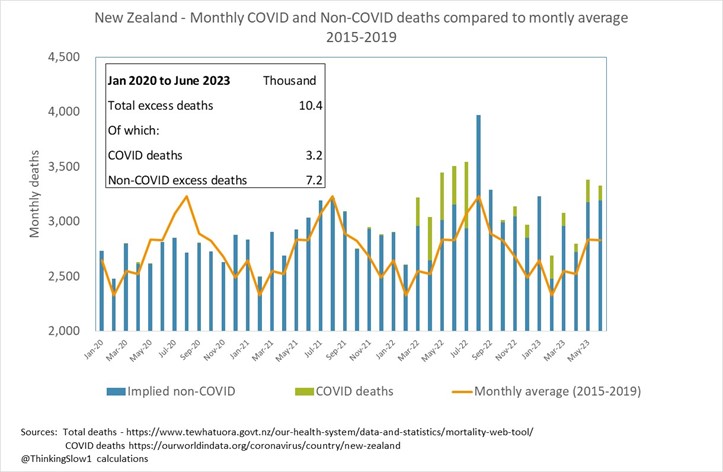MOST people in dissident circles will be aware of a significant leak of 4.4million vaccination records, maintained by the New Zealand National Health Service (Te Whatu Ora). The data was allegedly leaked by Barry Young, some selective findings were presented in a video by a micro political party in New Zealand and the data itself was anonymised by Steve Kirsch and made available for download and analysis. In a separate twist, people hosting that data have had their cloud storage accounts summarily deleted by New Zealand authorities, losing enormous amounts of data in the process. So I will be somewhat circumspect in describing what I have and have not looked at.
I believe that on balance the data in the leak may end up hiding the wood for the trees, although it has the potential to offer some insights if matched with data for the unvaccinated. The main reason I think this is that we have very good and completely legitimate records for a sample group known as the 5.2million population of New Zealand. The official data already yields reliable data on excess non-Covid deaths in New Zealand, which can further be attributed to vaccines, lockdown harms and the effects of healthcare disruption etc. The data download on the other hand is a non-random sample of 2.2million individuals. The non-random nature of the sample, together with the fact that there is no comparable data for the unvaccinated control group renders the leaked data somewhat redundant for the moment.
The key facts that we already have from official government sources are shown in the table and chart below.

So we know from official data that around 7.2 thousand deaths should be attributed to non-Covid reasons: I call these policy response deaths. I don’t think it will ever be possible to exactly allocate these deaths to a single cause. One extreme position will be to claim 100 per cent of non-Covid excess deaths are attributable to the vaccine, while the other side will maintain that vaccines are safe and effective and non-Covid deaths are attributable to other (unspecified) causes. In reality, the falling uptake of Covid vaccines is already a sign that the public has cottoned on to the fact that all is not right with the vaccines, and the vaccine death attribution debate may become increasingly theoretical and litigation related.
There are various methods for estimating deaths attributable to the vaccine, which in all cases generate figures which are orders of magnitude higher than the official adverse reaction database figures. As a finger-in-the-air exercise, it might not be unreasonable to split the difference and claim that 3.6 thousand deaths (from 7.2 thousand) may be attributable to the vaccine in New Zealand. One of the most interesting and least understood papers on this subject was produced by Professors Fenton and Neil who arrived at a jaw-dropping estimate of 51,000 vaccine-related deaths in the UK from a total of 120,000 excess deaths. Of these 51,000, they calculated that 16,000 were directly attributable to the vaccine and 35,000 were attributable to underlying conditions which were worsened by the vaccine. If applied to New Zealand (not comparable in many ways) that would suggest around 4.2 thousand vaccine-related excess deaths. Yet another method developed by Denis Rancourt et al suggests around 1.3 deaths per 1,000 injections, which would imply something more than all of the excess deaths in New Zealand would be attributable to vaccine. This would be very much at the high end.
In any event, it is becoming increasingly clear to the wider population that the risk-reward ratio for the Covid vaccine really doesn’t make sense. The data leak has already created two soundbites, both of which are false but have nonetheless entered popular folklore in some quarters. These are i) that 20 per cent of vaccinees died and ii) that the chance of this result being a fluke is one in ten billion (sometimes stated as one in one hundred billion). Neither statement has a basis in fact. Let’s look at the 20 per cent claim derived from the much-hyped Mother of All Revelations Loyal Party video.

Igor Chudov has already reviewed parts of this material; I agree with all of those observations and have easily been able to replicate his findings from his notes. I wanted to add additional observations, importantly we now know that there is an enormous variation in the average age of the batches (numbered 1 to 124) and that alone will drive a huge variation in the ratio of deaths/vaccinees. Almost nothing can be concluded on the quality of batches based on low, or high deaths/vaccinees ratios given the discrepancies in ages. For Batch-1 the average is 66 with an average at death of 85, also the average duration from vaccination to death is 58 weeks with no peak, which suggests that vaccination had no discernible impact on these deaths.
These variation in ages between batches negate the one in ten billion claim, which was based on a probabilistic estimate based on the assumption that the batches were comparable. It appears that Professor Fenton was misled on this point and he has made clear that very different age characteristics of these batches invalidates the probabilistic estimate of one in ten billion chance of this seemingly high deaths/vaccinee ratio being down to chance.
To make matters worse, 21.38 per cent is derived even from a small subset of Batch-1 which was already itself unrepresentative. The 21.38 per cent is based on 711 vaccinated, whilst the totals for Batch-1 were 2,979 vaccinees with 4,386 doses. Based on various Twitter exchanges it appears that this subset was chosen from those in Batch-1 who did not go on to have subsequent doses so this introduces even more bias. In summary, I think that it is safe to say that the 21.38 per cent statistic is meaningless and cannot be applied to any other group. I speculate that this was ‘sexed up’ to generate publicity and deliver on the M.O.A.R hype around the Loyal Party video.
One final part of the jigsaw is the claim that having many deaths falling soon after vaccination would be another strong signal; for reference in the case of Batch-1 there is no such signal. In the case of the database as a whole there is such a signal, but in reality this is difficult to interpret given bursts of mass vaccination into a highly seasonal pattern of all-cause mortality. It is difficult to know what this curve should look like: one commentator has questioned the assumption that this line should be sloping downwards. We come back to the conclusion that only a comparison with a matched unvaccinated control group (unlikely in the near future) would yield a really clear conclusion.
Conclusion
I believe that the leak on a stand-alone basis generates few meaningful new insights: even with a matched population of unvaccinated, the additional insights would be incremental to the solid data that we already have at the population level. Specifically, the acknowledgement that the majority of excess deaths at June 30 2023 were non-Covid and stood at 7.2 thousand (incidentally there is a lot more official data including deaths by vaccination status end point), this is the smoking gun!
I wanted to address one final point, which is that we are often accused of being divisive rather than getting behind our natural allies since we both agree that the vaccines do cause significant deaths, which are orders of magnitude higher than the data shown in official government statistics (New Zealand shows four vaccine related deaths). Our response to that is that we are attempting to get more integrity and honesty into decision-making, and debate and challenge the deliberate misrepresentation of numbers. In that context, we are as much opposed to someone quoting meaningless fatality numbers of 20 per cent as we are to government officials claiming vaccines are ‘safe and effective’, when the evidence points to the opposite conclusion.
Will be putting out further notes on this topic, including the conclusion that I don’t think this partial database will ever be useable for estimating vaccine deaths, working out vaccine effectiveness or carrying out a batch analysis.
This article appeared in Thinking Coalition on December 8, 2023, and is republished by kind permission.

